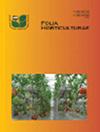Connecting college students with nature: An evaluation indicator system for the implementation of horticultural therapy programmes on university campuses
IF 1.8
4区 农林科学
Q2 HORTICULTURE
引用次数: 0
Abstract
The introduction of horticultural therapy to university campuses has gradually become an effective way to promote college students’ interaction with nature, improve their health and increase the quality of their study environment. However, many current studies have focused on measuring and evaluating the physical and mental health benefits of horticultural therapy programmes for college students, while less attention has been paid to exploring how to implement such programmes in a planned and sustainable manner. The main purpose of this study is to construct an evaluation system for the implementation of horticultural therapy programmes on university campuses, so as to better guide the sustainable development of campus horticultural therapy. The analytic hierarchy process (AHP) and the Delphi method were combined in this study. Delphi method was used to carry out two rounds of consultation for 10 experts, to select and revise indicators at all levels and establish an evaluation system. Expert and college student opinions were combined to determine the weight of indicators at each level using AHP. The evaluation system constructed by Delphi method included 4 indicators in the criteria layer and 12 indicators in the indicator layer. The weight analysis of AHP showed that horticultural therapy plan (0.341) was most important in the criteria layer, followed by the natural healing environment (0.289), the horticultural therapy team (0.190) and post-maintenance management (0.180). In conclusion, the evaluation system constructed systematically sorts out the elements of conducting horticultural therapy programmes on Chinese university campuses, which has good application and promotion value.将大学生与大自然联系起来:大学校园实施园艺疗法计划的评估指标体系
将园艺疗法引入大学校园已逐渐成为促进大学生与自然互动、改善大学生健康状况、提高学习环境质量的有效途径。然而,目前的许多研究都侧重于衡量和评估园艺疗法项目对大学生身心健康的益处,而较少关注如何有计划、可持续地实施此类项目。本研究的主要目的是构建大学校园园艺疗法项目实施的评价体系,从而更好地指导校园园艺疗法的可持续发展。本研究结合了层次分析法(AHP)和德尔菲法。采用德尔菲法对 10 位专家进行两轮咨询,对各级指标进行筛选和修订,建立评价体系。综合专家和大学生的意见,采用 AHP 方法确定各层次指标的权重。德尔菲法构建的评价体系包括标准层 4 个指标和指标层 12 个指标。AHP 权重分析表明,标准层中园艺疗法计划(0.341)最重要,其次是自然疗养环境(0.289)、园艺疗法团队(0.190)和后期维护管理(0.180)。总之,所构建的评价体系系统地梳理了我国大学校园开展园艺疗法项目的要素,具有很好的应用和推广价值。
本文章由计算机程序翻译,如有差异,请以英文原文为准。
求助全文
约1分钟内获得全文
求助全文
来源期刊

Folia Horticulturae
Agricultural and Biological Sciences-Horticulture
CiteScore
3.40
自引率
0.00%
发文量
13
审稿时长
16 weeks
期刊介绍:
Folia Horticulturae is an international, scientific journal published in English. It covers a broad research spectrum of aspects related to horticultural science that are of interest to a wide scientific community and have an impact on progress in both basic and applied research carried out with the use of horticultural crops and their products. The journal’s aim is to disseminate recent findings and serve as a forum for presenting views as well as for discussing important problems and prospects of modern horticulture, particularly in relation to sustainable production of high yield and quality of horticultural products, including their impact on human health.
 求助内容:
求助内容: 应助结果提醒方式:
应助结果提醒方式:


